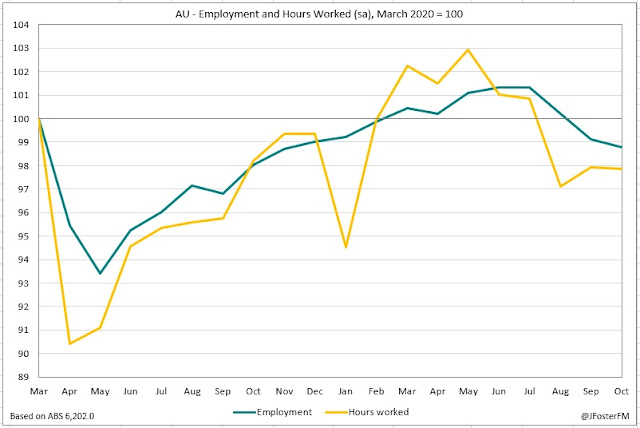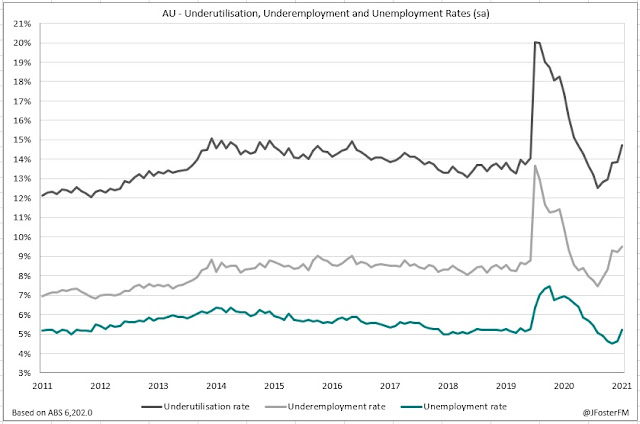Australian employment declined against market expectations falling by 46.3k in October, largely reflecting the effects of the lockdown in Victoria. North of the border, there were positive signs for the recovery in New South Wales where employment, participation and hours worked all lifted ahead of the reopening. With lockdowns now ended and indicators of labour demand elevated, the recovery should broaden out over the coming months. The speed of the rebound in participation back to pre-Delta levels is now the key factor for the recovery.
Labour Force Survey — October | By the numbers
- Employment (on net) fell by 46.3k in October, disappointing the market consensus for a rise of 50.0k. September's fall was revised to show a larger decline of -141.1k from -138k previously.
- Headline unemployment lifted from 4.6% to 5.2% (vs 4.8% expected), reflecting rises in unemployment and in the labour force.
- Labour force participation increased slightly, to 64.7% from 64.5%, driven by a return of workers in NSW (+0.8ppt to 62.6%).
- Hours worked softened in October falling by 0.1%m/m (-0.4%yr). A 3.9% surge in NSW ahead of the reopening was offset by weakness associated with the Victoria lockdown and school holidays in the other states.
Labour Force Survey — October | The details
A number of crosscurrents affected the outcomes in today's labour market update. As touched on in the preview, the ABS shifted the reference period for the October survey forward by a week relative to what would normally have been the case, due to 2021 being a Census year. This meant that the reference period ended on October 9, before NSW had reopened and around 2 weeks before restrictions started to be eased in Victoria. It also reflected the effects associated with school holidays in some of the other states, between late September into early October. Although the ABS's seasonal adjustments are applied to account for the earlier reference period, this was an especially unusual time when considering the lockdowns in the two most populous states.
These factors help to explain the weakness in October's employment outcome of -46.3k relative to the 50k rise forecast by markets. Overall, this takes the fall in employment over the Delta lockdowns to -333.7k since July. This represents a contraction of 2.5% over the period, much smaller than the 6.6% fall seen at the outset of Covid. In October, the full time segment (-40.4k) drove the headline fall in employment, with part time employment down modestly (-5.9k). But over the Delta lockdowns, part time employment has fallen by 250.3k, substantially larger than the 83.4k fall in the full time segment.
Across the states in October, preparations ahead of the reopening led to a 21.7k rise in employment in NSW. But with the lockdown continuing in Victoria employment there fell by another 49.6k. Declines were also seen in Queensland (-7.8k), Western Australia (-4.4k) and Tasmania, coinciding with school holiday periods.
Nationally, hours worked were down 0.1% for the month, smaller than the decline in employment (-0.4%). This left total hours worked down 2.1% on pre-pandemic levels. The recovery in NSW continued in October with hours worked up 3.9% after the tide started to turn in September with a 2.7% rise. However, the gain in NSW was offset by the impact of the lockdown on hours worked in Victoria (-4%m/m), while hours worked across the other states and territories fell sharply (-6.8%m/m) reflecting people taking leave during school holidays. According to today's report, around 189k people worked zero hours in October due to 'economic reasons', including around 97k in Victoria rising substantially from the previous month (74.2k).
These dynamics also affected participation in the month. Nationally, the participation rate lifted slightly, from 64.5% to 64.7%, recording its first rise since May. NSW drove this increase as people started returning to the labour market ahead of the reopening; participation in the state lifted from 61.8% to 62.6% but was still well down on pre-Delta levels. However, the lockdown drove a further fall in Victoria (64.6% from 64.9%). Participation across the other states fell in Queensland, Western Australia and Tasmania but lifted in the other regions, including a 0.2ppt rise in the ACT (68.4%) as its lockdown came to an end.
The configuration of rising participation into falling employment drove a sharp increase in the unemployment rate, from 4.6% to 5.2%, to its highest level since April. As more people return to the labour force in the coming months, the unemployment rate could drift higher, but the very elevated level of job vacancies, including the 7.8% rise reported by the federal government for October this week (see here), highlights labour demand is very strong. Reflecting the disruptions from lockdowns through the hit to hours worked, broader measures of spare capacity have been on the rise since mid year and this continued in October. The underutilisation rate has risen to 14.7% and the underemployment rate is now at 9.5%, with both backing up to their highest levels since late 2020.
Labour Force Survey — October | Insights
A weak report today but this is one that more reflects statistical volatility than the underlying conditions in my interpretation. With lockdowns having run their course after vaccination rates reached key thresholds, the consensus can now form around a larger rebound in November than previously expected. Labour demand is clearly elevated in many industries and will support hiring. The key to the recovery now is the extent and pace at which participation rebounds.









